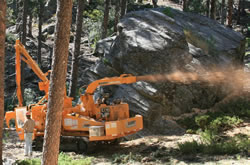
National Fire Plan Success Story
Reducing Fuel Loads around an American Icon: Project at Mount Rushmore Provides Multiple Benefits
Mount Rushmore National Memorial, South Dakota
National Fire Plan - Fuels Reduction
2010

Ponderosa pine trees less than 10 inches in diameter were removed throughout the project area. In areas where the terrain allowed, a chipper was used to grind up the material. In other areas, the material was piled for burning when weather permits.
An ambitious fuel reduction project began with a planning meeting at Mount Rushmore in February 2010. Prompted by an ongoing mountain pine beetle outbreak in the central Black Hills, staff at Mount Rushmore requested assistance from the NPS Midwest Regional Office to help prepare a plan to mitigate the impacts of a potential mountain pine beetle infestation. A plan was completed by a small group of specialists with input from memorial staff, the Black Hills National Forest, and other local stakeholders.
One component of the plan included mechanically thinning more than 525 acres of the memorial, most of which had not received any type of fuels treatment (mechanical or fire) since the establishment of the memorial in 1925. Two methods were used to complete the project. The first included crews with chainsaws removing trees less than 10 inches in diameter. These trees were then fed through a tracked chipper and the chips were broadcast on the site. Crews using chainsaws cut trees less than 6 inches in diameter and stacked them into piles that will be burned when weather conditions allow in more rugged parts of the project area.
Mount Rushmore preserves one of the largest contiguous stands of old-growth ponderosa pine stands remaining in the Black Hills. Removing most of the smaller trees greatly reduces the potential for a stand-replacing crown fire within the memorial. In the event of a fire, these smaller trees act as a ladder fuel, which could carry fire into the crowns of the large, mature trees. This also makes it more feasible to utilize prescribed fire at the memorial, which will be the next step in restoring the old-growth ponderosa pine forest. Ultimately, it is the hope that these treatments will make the forest more resilient and resistant to infestation of mountain pine beetle.
Contact: Eric Allen, Fire Management Officer, Northern Great Plains Fire Management, (605) 745-1159.